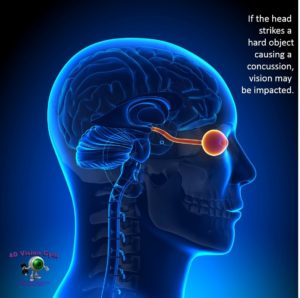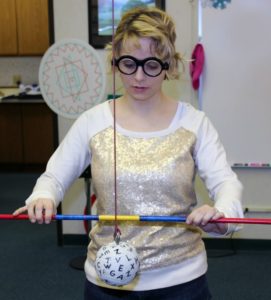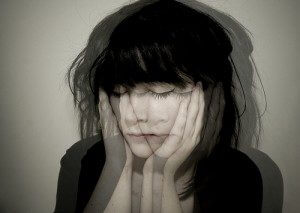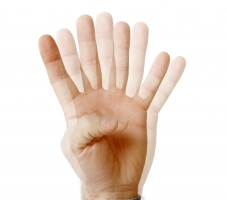Research estimated the prevalence of vision problems experienced by patients after concussions may be as high as 69%. Concussions can also cause damage to the cells of the brain that carry signals. These changes impact on many functions affecting activities of daily living especially, the processing of vision. In children, the most common cause of concussions is sports, specifically contact sports such as football and soccer In adults, motor vehicle accidents and falls are the most common causes of concussions.
With so many neural connections within the brain involved with the aspect of vision, it is no wonder that vision problems are so common following an acquired brain injury. There are several potential visual side effects of a concussion- some may improve with time, some remains the same, while others respond very well to active treatment.
Vision symptoms from Concussion
Symptoms may vary among concussed patients, but typical symptoms include:
 Blurred vision (far, near or both)
Blurred vision (far, near or both) - Double vision
- Poor eye tracking ability
- Focusing
- Loss of binocular vision (eye alignment)
- Eye strain
- Fatigue
- Glare, or light sensitivity
- Headaches
Concussions or injury to the brain can have the following effects on the visual processing system. These include:
- Visual spatial awareness, causing disorientation, impaired balance and movement stability, reduced depth perception impacting driving and navigating stairs, and reduced confidence in busy environments
- Focusing dysfunctions, causing poor visual attention for sustained tasks including reading, computer, sport, driving, conversation and movies.
- Dysfunctions of eye movement control, affecting reading and writing fluency, scanning for driving, sports and mobility outdoors
- Binocular vision instability, causing reduced attention for any visual task, irregular fluency for reading, copying and writing , double vision, eye turn, poor depth perception and judgement for distance or near activities
- Photosensitivity and heightened glare symptoms associated with sunlight, artificial lighting, contrast patterns and flicker, often causing motion sickness
- Visual processing skills issues, causing difficulty using visual and other sensory information sequentially, rapidly and effectively.
Treatment for vision problems from Concussions
 Treatment options for a functional vision problem resulting from a concussion will vary for every patient. These visual problems can be successfully controlled or eliminated with glasses, contact lenses, vision therapy or a combination of treatments. After diagnosis, our optometrists at Eyecare Kids will recommend suitable treatment options to best address your visual conditions.
Treatment options for a functional vision problem resulting from a concussion will vary for every patient. These visual problems can be successfully controlled or eliminated with glasses, contact lenses, vision therapy or a combination of treatments. After diagnosis, our optometrists at Eyecare Kids will recommend suitable treatment options to best address your visual conditions.
The goal of vision therapy following a brain injury is to restore the patient’s visual function. The length of treatment will also vary with each patient based on how many visual skill areas are affected and their individual case. Each case is unique, and we are Eyecare Kids will help address our patient’s visual concerns and needs to achieve the best possible outcome.
Success rates for vision therapy after concussions
In the study “Vision Therapy for Post Concussion Vision Disorders”, showed patients who completed therapy had
- 85% of patients with Convergence Insufficiency were successful and 15% were improved
- 33% of patients with Accommodative Insufficiency were successful and 67% improved
Our Success Stories
We are happy to share one of our many successful stories we had with our patients and the journey they took to achieving that success. It was all about commitment, patience and bravery.
 Kate, a 7 year old girl in grade X was referred to a children’s optometry practice with her mother after having a fall. She had fractured her arm and had a possible trauma to her head with sudden onset of double vision in February.
Kate, a 7 year old girl in grade X was referred to a children’s optometry practice with her mother after having a fall. She had fractured her arm and had a possible trauma to her head with sudden onset of double vision in February.
Kate’s mother being in the medical field, understood the urgency of her condition. Her daughter was complaining of double vision so an MRI scan was performed to rule out any other serious injury caused by the fall.
Thankfully, the MRI scan results were clear.
The next course of action was to see an eye specialist (ophthalmologist) who after extensive testing referred Kate to our Optometrist, Soojin Nam, Behavioural Optometrist at Eyecare Kids. She conducted a comprehensive binocular assessment and found that Kate had developed an intermittent exotropia which meant she saw double vision frequently at near and distance.
Kate’s mother was also concerned as this problem impacted her schooling causing her daughter’s grades to drop. Kate exhibited difficulty with most tasks including reading, writing and she was falling behind in her work.
Kate had only very little to no 3D vision, and her eye focusing system was very reduced – reduced to a focusing level of a 47 year old person. Soojin recommended vision therapy for Kate to help rehabilitate her binocular vision back to how it used to be before the accident.
Asma Fayad shared “The first few sessions of vision therapy were very difficult for Kate because there was two of everything. Even a simple task of catching and hitting back a swinging ball was too difficult as she was always trying to find the real object of the two images. But Kate was a determined girl – she pushed herself until she gained binocular vision. Finally she could see a single image and not double vision! After completing a 3 months program of vision therapy Kate’s results improved dramatically. Her eye focussing and movements had improved significantly. Kate was no longer getting double vision and no longer has an eye turn. Kate even achieved 3D vision (stereopsis) which means now she can watch all those 3D movies she was having trouble with before. Kate is now doing everything as before with increased confidence. Kate is scoring excellent results at school and is a very fast reader. She is back playing the sports she loves.” Asma Fayad, Orthoptist
Lets take a step forward
These visual conditions can be quite distressing as it impacts on your ability to learn, work and function in day to day activities. For Kate tasks like reading, or catching a ball become difficult to do because of the double vision she had. The good new is that many of these conditions do respond well to spectacles, vision therapy or a combination of both.
Some come in to see us at Eyecare Kids to experience and share the successful journey that Kate undertook to seeing single and clear vision.

 Blurred vision (far, near or both)
Blurred vision (far, near or both) 